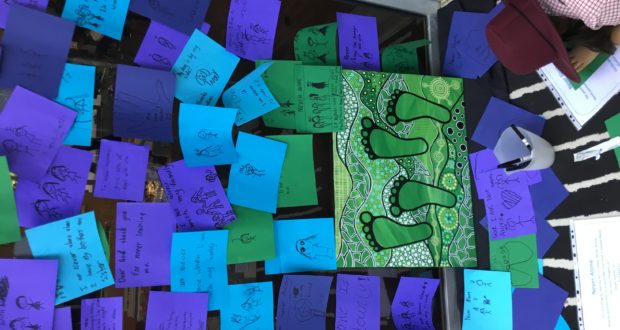Before you could spell, when you were a small child, what did the word “prayer” mean to you? Can you remember the first time you prayed? Stephanie Controneo, former primary school chaplain at Moreton Bay College, explores spaces can open up children’s understanding of prayer.
As a primary school chaplain, inviting children and staff to pray during chapel services and assemblies is a regular part of the role. Very often, you witness children encountering their first experiences with prayer. During religious education lessons, in our inquiries and wonderings, lots of questions about prayer and faith are expressed and discussed.
And I have had my own wonderings …
What if there was an invitation for students to pray in a different way?
What if children could choose to be involved in prayer and reflection for an entire RI lesson?
What if there could be a place for prayer and reflection during lunch break and after school?
What if the final week of a long, busy term could be spent in calming, quiet, interactive prayer experiences?
How can school chaplains facilitate opportunities for students to choose to engage in prayer and to grow in their spiritual development?
Prayer Spaces in Schools, developed in the United Kingdom in 2007, is a hub for resources designed to provide an opportunity for children and young adults to experience prayer in a safe, creative and age-appropriate space. Using these resources, and with support from staff, parent helpers and Year 6 student leaders, the first prayer space occurred at Moreton Bay College Girls Primary School in the final week of Term 2, 2018.
A dozen prayer stations were set up in the garden outside the college library. These stations enabled the students to express emotions such as forgiveness and grief and loss, to release worry and face fear, and to be grateful and hopeful. Each group of students to pass through were gathered together beforehand and invited to participate.
Each station was identified as a safe place, with no names being recorded on prayers to ensure privacy and to allow personal expression. Parent volunteers were recruited to assist with restocking stations and to help younger readers with the prayer station instructions. The enthusiasm and support of the space grew each day, along with the number of prayers that were expressed.
Conversations and surprises included students designing and planning their own prayer stations for the future, requests for another prayer space next term and a visit from members of the local Bayside Uniting Church community.
For many within the college primary school community, this prayer space has completely changed and enhanced their understanding of the word “prayer”.
The prayer station initiative received fantastic feedback from parents and students alike, with one parent offering the below reflection:
“As a parent helping in the prayer space I loved how it opened up prayer as a bigger concept to the girls, seeing them come to realise that prayer isn’t just repeating something during a chapel service or asking for something they want, but rather it’s a way of communicating with God.
“Whether it was praying for others, remembering loved ones, saying sorry, or handing over their worries to God, the prayer space showed them that prayer is something God gave us to help us in every area of our lives.”
Another parent, moved by the experience, commented that if prayer had been explained and experienced in this way during her childhood, it would have had a profound impact on how her faith developed.
Students offered the following comments:
“At the empty prayer station I could reflect on the people in my family that have sadly passed away and not be judged by other girls as some of them also know what it feels like.” “The Be Still prayer station was my favourite prayer station because it was a place to be quiet and reflect on everything in our lives. It was peaceful and calm. It made me feel relaxed. This is a place where you can block out all the sound and the people and just think about yourself. The tent, in my opinion, was like a fence keeping me and protecting me from the surrounding world just like God does, except visual.”
“The Wheelbarrow was the prayer station that helped me the most and helped me let go of my worries. It symbolised getting rid of something that worried us or upset us. I wrote down something that worries me and I threw it into the wheelbarrow. Now that is no longer worrying me and I can move on. The prayer space was calming and peaceful.”
For more information on Prayer Spaces in Schools, including findings from a qualitative and quantitative study into the impact of prayer spaces on the spiritual development of children and young people, go to www.prayerspacesinschools.com
 JourneyOnline
JourneyOnline







